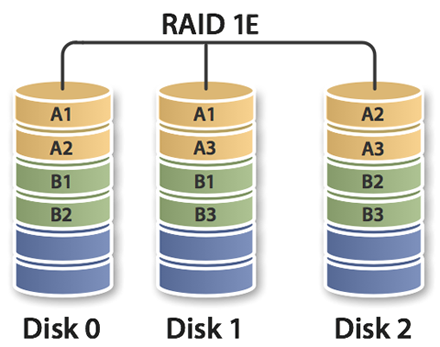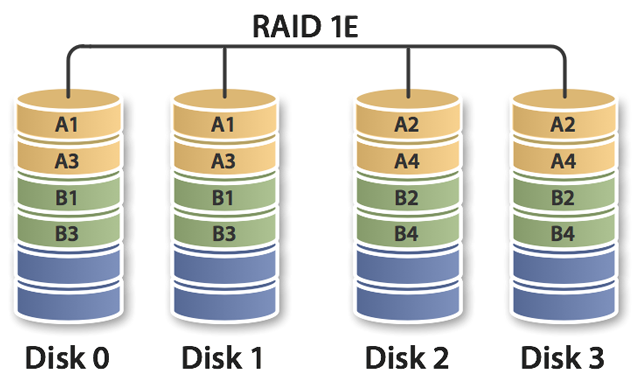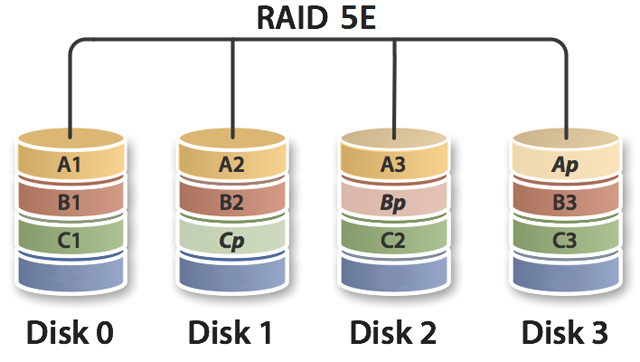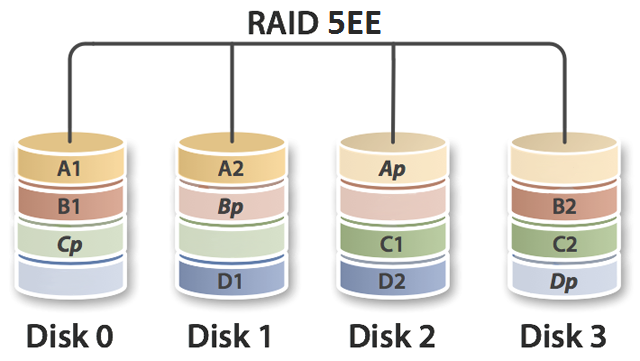This matrix is a combination of RAID 1 and 0. Data is divided into strips as in RAID 0 and spread across all disks in the array. But for each set of strips is assigned a copy (as in RAID 1) which is recorded with a shift of one block / disc. RAID levels 1E requires a minimum of three disks, and with an even distribution of the number of stripes on the disk is identical to RAID 10 The advantages of array-level 1E is better than RAID 1 performance, though it is mainly thanks to a larger number of disks. This advantage, however, increases if the controller does not support simultaneous reading of several drives in RAID 1, or does so poorly. As a defects we can indicate a higher minimum number of disks needed to build the array, 50% reduction in space for the user, and the fact that a comparable number of disks in RAID 1 survive breakdown more of them (three-disks RAID 1E - one, RAID 1 - two). Extended mirrored matrix is also practically implemented only in the newer models of hardware controllers.

In theory, resistance of levels 1E on the failure of the drives in the case of even their number is similar to RAID 10, that means, that may be damaged half of the disks. As can be seen from our tests is not entirely true, because on the Adaptec 6405 during a simulation of fail two of the four drives in the array 1E, matrixpasses into a state of total failure, regardless of the choice of drives that were removable. For configurations with an odd number of disks may become damaged (n-1) / 2 drives, where n is the number in the matrix, which for three-disks array gives us a one disk, and for five-disks - two. Damaged discs can not adjoin each other which reduces the number of possible configurations of failure several disks not stopping work of the array.

Data recovery in texas: hard drive raid
RAID 5EE is an enhanced form of RAID 5E, although they are considered as equivalent. Both of these matrices expanding (fifth-level of array) in built-in in the structure the "hot-spare" drive, both are matrices with a custom list of RAID levels. 5E and RAID 5EE thus require a minimum of four drives. In theory, they are resistant to failure even up to two drives. In practice, however, is little difference. Drives may have failure one by one at a time interval needed for the so-called matrix compression. The point is that if a disk failure in the matrix 5E and 5EE built into it a spare disk it is used to compress the matrix to the usual array RAID 5. Only after then may be failure of the second drive, which is a resistant for failure of the fifth level matrix. Depending on the implementation of RAID 5E/5EE after compensation (ie, after failure of one disk) is now permanently RAID 5, or after replacing the failed drives is back expansion from the RAID 5 to array 5E/5EE. The latter case is present in the being tested Adaptec controller. The main advantage of these arrays over RAID 5 is of course built-in "hot" spare drive. The second advantage is greater than in RAID 5 performance, but it is burdened with the increased the minimum number of disks to four and a smaller available capacity (with the same number of disks in RAID 5).

Both levels of RAID, as already mentioned have built-in in their structure the spare disk. But there is a difference between them. RAID 5E distributes its blocs at the beginning of all component disks (like RAID 5 on four disks), leaving a free space at the end of each disks, which globally is the size of a one disk. This is a built-in hot-spare drive. By spreading strips on four and not three, as in the case ofRAID 5 with the ordinary (or dedicated), a global hot spare, the performance of such a matrix is simply bigger, like RAID 0 on the four disks is faster than that of the three. The fact that all areas of the "working" are on the start of disks may be marginal but yet measurable impact on improving the speed of the matrix, because the slowest drives on a regular HDD areas at the end of disks are reserved as a spare. The main decision to make when choosing a RAID 5E/5EE or RAID 5 on three drives with dedicated hot spare is to determine whether it is more important for us is performance, or the fact that a dedicated hot-spare drive is at rest and may even be completely disabled by the controller, and thus no consuming.

Data Retrieval among other things, specializes in RAID data recovery services.
RAID 5E and RAID 5EE differs the fact that the spare area instead of being at the end of the disks components of the matrix is distributed in the form of strips next to parity strips (as RAID 6, but instead of a second set of parity strips are strips of empty space). This has two implications: compensation of such a matrix is faster than the alternative RAID 5E. Increase the speed, mentioned in the previous paragraph in this case is absent. Depending on the implementation of both types of arrays fifth extended, permit a maximum of eight to sixteen drives, although the gain of speed and effort I / O operations associated with the compression and expansion of the matrix reduces the maximum number to the lower value. In addition, both matrices allow to create on them only one logical drive. The last disadvantage of these arrays is their negligible availability similarly to RAID 1E.
Qualified RAID data recovery and encryption specialists in Tuscon,AZ will routinely recover your crashed or failed RAID arrays.




